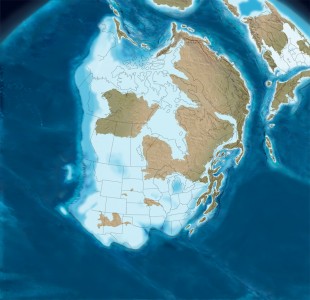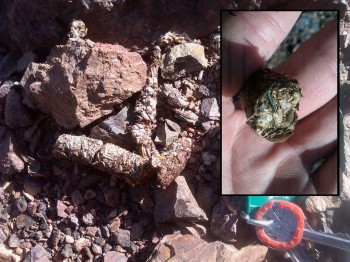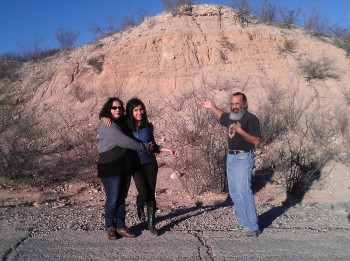
Paleosouls: the author and her parents enjoying the
Plio-Pleistocene sediments in southern Arizona.
Vacations used to be a time when I took my mind off work. I would take a few days to decompress, relax, and, more specifically, escape from the ancient past that I study on a daily basis. However, the farther along I get into my PhD research, the harder it has become to escape from a paleoecological mindset and return solely to the present. In fact, as it turns out, I’ve come to prefer this paleo-tinted reality. The world becomes a much more exciting place with prehistory as a backdrop, which became very clear to me this weekend when my parents, fiancé and I took a weekend trip to Bisbee, a small mining town in southern Arizona.
The drive from Phoenix takes about four hours. We’ve taken this drive many times and I always stare absentmindedly out the window appreciating the desolate beauty of the desert landscape. The craggy black mountains were just mountains and, until recently, I assumed that the landscape had always looked as it does today; desolate sands spotted with cacti. However, over the past few years, I’ve come to appreciate that we pass through millions of years of earth’s natural history on this short drive.
This time, as I looked out of the car window, I saw mountains formed by violent volcanic eruptions or the folding of the earth’s surfaces. I newly appreciated the limestone hills, which are being slowly chipped away by mining, as being deposited by shallow seas that came and went over millions of years. Even as a student of paleontology, I sometimes find it difficult to imagine that, long before highways snaked across the southern Arizona basins, a warm, shallow sea covered the region. Hundreds of millions of years ago, extinct creatures such as molluscs made their homes in these seaways. Calcite from the shells of these creatures deposited the limestone bedrock that is now made into the concrete used to build homes and sidewalks. In fact, you probably come across these ancient materials on a daily basis without realizing it!

A snapshot of North America approximately
480 million years ago: much of the Southwest
is covered in shallow seas.
Photo credit: Dr. Ron Blakey, Northern Arizona University Geology.
As we drove farther south, we came across much younger sedimentary deposits (only a few million years old). With a bit of experience, the layers of these deposits can be read like a book; telling the stories of ancient rivers and land surfaces upon which mammals, similar to those found on the African plains today, made their homes. I couldn’t help but cajole my family into making an unplanned stop to examine these deposits and collect a few soil samples located right next to the highway. In my dissertation research, I study the information that soils can tell us about ancient environments, such as what types of vegetation were present in association with paleo-animal communities. To my own surprise, I’ve become much more excited about finding accumulations of soil than I would have ever imagined myself to be.

Carnivore poop!: the possible coyote poop
and hotel room key for scale with an inset
showing a close up of the undigested insect
exoskeletons and plant seeds.
I also study the way animals fossilize, which I now realize I can do anywhere (as can anyone!). On my morning runs on this trip, I found myself continually stopping (causing a family pile-up behind me) to pick up the carnivore poop that litters the trails. I encourage anyone interested in natural history to collect these unlikely treasures as they record, not only remnants of a small carnivore’s diet, but examples of the diversity of micromammals and insects in a region. The poop I found on these runs recorded that the small carnivores outside of Bisbee, probably coyotes, have recently had more luck finding insects and berries than mice and birds, whose bones I sometimes find. In the fossil record, we also find fossilized poop, called coprolites that record similar stories of long extinct carnivores. The present helps us create a baseline with which to compare these fossil samples.
On our final day on vacation, to my mother’s initial dismay, I insisted that we cut our antique shopping short to visit a few well-known archeological sites that are located just miles from Bisbee. These localities represent some of the most well documented cases of ancient humans hunting megafauna in North America. As a vegetarian, I was saddened by the thought of mammoth for dinner but also touched to learn that one of the unlucky mammoths had been named “Big Eloise” by the archeologists who excavated the sites. The people responsible for these sites, called the Clovis, likely made the long trek to North America across glacier sheets through ice-free corridors in the area that is now Canada. Eleven thousand years ago, these people found a comfortable home in southern Arizona, as did giant sloths, tapirs, mammoths and mastodons. We visited this site and walked across the same ancient land surfaces as did these giant creatures and peoples. Tools and evidence of fire hearths made by the Clovis communities can still be found littering these surfaces. As it turns out, ancient people were as messy as those today… and destructive. Shortly after the Clovis sites are found in the Americas, the megafauna such as mammoths, mastodons, and giant sloths disappeared from the fossil landscape. Though the appearance of humans coupled with the loss of these animals is not causatively linked, we can use this prehistoric association to take pause and examine our own impact on the large mammals that exist today, many of which are critically endangered.

Southern Arizona then and now: unlike the harsh, desolate landscapes of today, the Clovis likely encountered a much more green, woody environment with lots of large mammals. Mammoth photo from Science Magazine, 2008.
On a less pessimistic note, I wanted to share my experiences this weekend as a reminder that we can link the past to the present simply by taking time to notice nature and geology, even within and around urban areas. Vacations are a chance to travel not only to new places but also back in time. I often take my niece and nephew on these time travel trips inside of Phoenix, collecting bones, carnivore poop, and recording the wildlife we see. As paleontologists or paleo-enthusiasts, it is our job to help others find the excitement in these seemingly innocuous piles of dirt and rock upon which we traverse on a daily basis. Making these links can be fun and may even generate reflection on our current actions and impacts on the environment.
For Further Information:
You can learn more about paleontological sites in DC and the surrounding areas by visiting the Smithsonian website:


